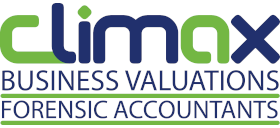I’ve created this video to show you how easily you can get an indicative value for any business using our Free Online Business Valuation Calculator. Watch the video, then use the calculator at the free business valuation calculator .Read on to see the business valuation methods used by Climax Business Strategies Chartered Accountants.
Read below if you want to know how the calculator works, but don’t worry, we do all of the hard work for you and explain our methods in the free 7 page business valuation report emailed to you at the end of the calculator.
The valuation method
The transfer price of any business (or any asset for that matter) will almost always come down to the agreed price between a knowledgeable and willing but not anxious seller and a knowledgeable and willing but not anxious buyer. The purpose of a valuation therefore is to indicate to the seller and/or the buyer what price would represent a favourable financial outcome to them based on their required rates of return. The purest method of valuation is the discounted cashflow (or net present value) approach however this method requires precise knowledge of all cash inflows and outflows between now and infinity for the business. Whilst this method is great for some financial assets with guaranteed cashflows it is impossible to apply to a business with variable cashflows.
The next best alternative used by most business valuers is a modification of the above method called the capitalisation of future maintainable earnings method. This method requires the valuer to forecast the most likely annual earnings (profits) figure that will then be used as an annual recurring amount in the calculation. The valuer then applies a capitalisation rate to those earnings based on a required rate of return to give the business a value.
Future maintainable earnings (profits)
The earnings will be calculated based on the past performance of the business (up to 3 years) as well as an estimated one-year projection provided by the applicant in the form of an estimated natural growth percentage. The net profit from the financial statements is adjusted to take into account various factors that are artificial or non-commercial amounts in the financial statements. Read the instructions in the calculator for more details on each of the adjustments.
The adjusted earnings before interest and taxes (EBIT) for each year are then weighted based on some generic assumptions to formulate a weighted average EBIT or future maintainable earnings, which is considered to be the likely annually recurring earnings amount going forward based on the methods and assumptions used.
Capitalisation rate
The capitalisation rate is inversely proportional to the required rate of return on the investment in the business. The higher the required rate of return, the lower the capitalisation rate and hence the lower the business value. Conversely, if there was no risk investing in this business the required rate of return may be as low as 5% and the business would be valued at 20 times the future maintainable earnings. This is never the case though as there are many inherent risks associated with running businesses. It is more likely that the required rate of return would be between 15% and 100% and corresponding capitalisation rates between 7 and 1 times respectively. The more risk, the higher return an investor would need compared to the investment outlay to make the investment.
In our indicative value calculation the amount of return is constant (future maintainable earnings) so the only way to change the rate of return is to change the value of the business. The higher the required rate of return, the less that the business is valued for the same level of future maintainable earnings.
There are 7 factors that influence the required rate of return in this indicative value report. Bear in mind this is an oversimplified example as in practice the factors could total over 100. The applicant’s responses to these factors have a significant impact on the indicative value of the business.
Assumptions relied upon
Valuing a business is a complex science that requires an enormous amount of information gathering, due diligence and industry knowledge to give an accurate opinion of value. Due to the limited scope of the indicative value report the following assumptions have been made. These assumptions may or may not be accurate and will depend on the specifics of each business.
- The information provided by the applicant is materially correct;
- The past is a good indicator of future performance of the business;
- The economic, industry and geographic factors are stable;
- Key customers, suppliers and employees are supportive;
- All related party transactions are at fair value except for those specifically identified in the adjustments;
- All inventory, plant, equipment, fittings and fixtures necessary for the operation of the business are included;
- All depreciation amounts are book entries only and no significant upgrades of assets are required in the near future; and
- All necessary intangibles and regulatory permits are transferable.
How much goodwill does the business have?
Goodwill is simply the difference between the value of the business and the values of the identifiable net tangible assets (excluding bank loans and other loans). Should the indicative value be greater than the net tangible assets you have that much goodwill but alternatively, should the indicative value be less than the net tangible assets of the business, then the business would have negative goodwill and the assets would hold the only saleable value.
What to do next
Simply go to the free business valuation calculator and enter your details into the free business valuation tool to find out what your business might be worth. Then browse the climax business strtegies site to find out how to increase the value of your business. Browse our services, watch our videos and read our blog to get the latest information on growing and sustaining a high performing business with the potential of selling it.
